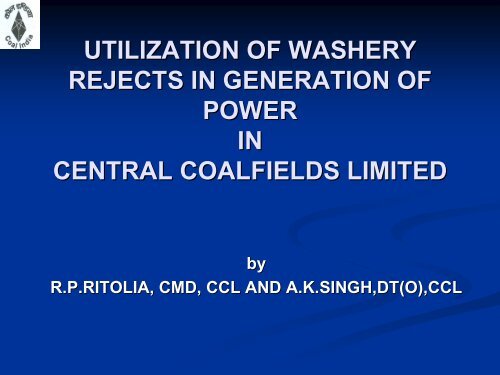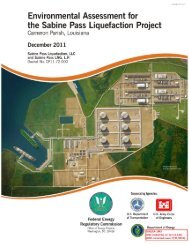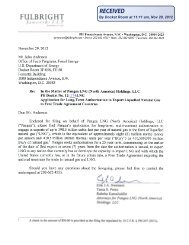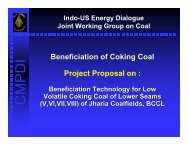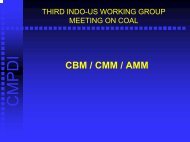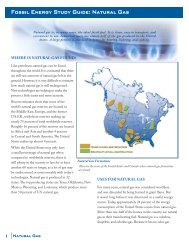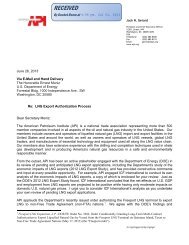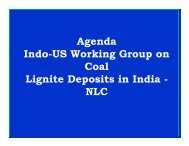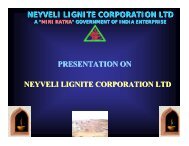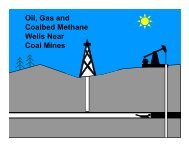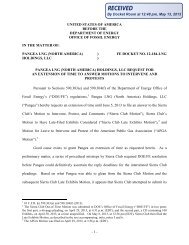WELCOME TO Presentation on - Office of Fossil Energy
WELCOME TO Presentation on - Office of Fossil Energy
WELCOME TO Presentation on - Office of Fossil Energy
- No tags were found...
You also want an ePaper? Increase the reach of your titles
YUMPU automatically turns print PDFs into web optimized ePapers that Google loves.
CCL – LOOKING AHEAD2016-17 : 115 MT Coal(Terminal Year <strong>of</strong> XII Plan)2011-12 : 78 MT Coal(Terminal Year <strong>of</strong> XI Plan)2006-07 : 41.32 MT Coal(Terminal Year <strong>of</strong> X Plan)2001-02 : 33.81 MT Coal(Terminal Year <strong>of</strong> IX Plan)
Central Coalfields Limited …… THEN & NOWTHEN1956 : Formati<strong>on</strong> Of Public Sector Company –Nati<strong>on</strong>al Coal Development Corporati<strong>on</strong> Ltd.1972 : Nati<strong>on</strong>alisati<strong>on</strong> <strong>of</strong> Coking Coal Mines.1973 : Nati<strong>on</strong>alisati<strong>on</strong> <strong>of</strong> N<strong>on</strong>-Coking Coal Mines.1975 : CENTRAL COALFIELDS LIMITED – Reorganisedunder Coal India Limited - Holding Company1986 : Truncati<strong>on</strong> <strong>of</strong> CCL , Formati<strong>on</strong> <strong>of</strong> NCL(Singrauli) &MCL (Talcher)INHERITED- a large number <strong>of</strong> small mines WITH Large workforceRESULTED CCL was left with 55% producti<strong>on</strong> capacity with 85%manpower <strong>of</strong> erstwhile Company Large and productive mines producing high volume (45%producti<strong>on</strong>) with less men (15% men) have g<strong>on</strong>e to otherCompaniesNOW : 11 Areas , 63 Mines
Presently CCL has …Operating Mines : 63 Mines grouped in 11 Areas(26 Underground + 37 Opencast)Washeries : 7 (4 Medium Coking Coal+ 3 N<strong>on</strong>-Coking Coal)Operating Coalfields: 6 (East Bokaro, WestBokaro, North Karanpura ,South Karanpura, Ramgarh,& Giridih)Workshop : 1 Central Workshop (ISO 9001Certified) + 5 Regi<strong>on</strong>al Workshops(3 <strong>of</strong> them ISO 9001 Certified )
OPERATING COALFIELDS OF CCL COMMAND AREA66. Giridih14. West Bokaro1. North Karanpura4 5235. East Bokaro2. South Karanpura3. RamgarhRANCHICOALFIELDSAREAS1. NKPA NK , Piparwar, Rajhara2. SKPA Barka-Sayal,Argada3. RAMGARH Rajrappa4. WEST BOKARO Hazaribagh,Kuju5. EAST BOKARO B&K, Dhori, Kathara
BACKGROUND• India is embarking <strong>on</strong> transformati<strong>on</strong> fromdeveloping ec<strong>on</strong>omy to developed ec<strong>on</strong>omy.•Electricity Act 2003 and Nati<strong>on</strong>al Electricity Policycreated c<strong>on</strong>ducive envir<strong>on</strong>ment for growth <strong>of</strong>Power Sector commensurate with ec<strong>on</strong>omy.•Need <strong>of</strong> the hour – Strategic planning <strong>of</strong> energyresources for sustainable development over l<strong>on</strong>gtime horiz<strong>on</strong>.•Washing <strong>of</strong> n<strong>on</strong>-coking coal for power utilizati<strong>on</strong>may become the norm in future.•Gainful utilizati<strong>on</strong> <strong>of</strong> reject produced bybeneficiati<strong>on</strong> <strong>of</strong> raw coal has evoked c<strong>on</strong>siderableinterest in recent / future times.
NEED FOR BENEFICIATION• Less quantity <strong>of</strong> high quality coal reserves inrelati<strong>on</strong> to growing demand• High cost <strong>of</strong> transportati<strong>on</strong> <strong>of</strong> dirt al<strong>on</strong>g with coaland its subsequent disposal as ash or slag addingto the cost, thus, more captive investment.Disposal <strong>of</strong> ash by c<strong>on</strong>sumers is a difficult problem• Increased demand <strong>of</strong> lower ash coal i.e. highcalorific value fuel.• Envir<strong>on</strong>mental awareness and requirement at usersend.• Greater c<strong>on</strong>cern and c<strong>on</strong>sciousness <strong>of</strong> c<strong>on</strong>sumersabout quality.
SNAdvantages <strong>of</strong> using beneficiated coal(study c<strong>on</strong>ducted by CMPDI at Satpura TPS )ParametersBenefits1. CHP2. Coal Mills3. Furnace, Boilertube etc.4. Low grade coalreserves.5. Envir<strong>on</strong>ment6. Railway utilityFrequent jamming that was taking place with ROMcoal was avoided with beneficiated coal due touniform size, absence <strong>of</strong> foreign materials.Low ash c<strong>on</strong>tent in the beneficiated coal resulted inreducti<strong>on</strong> <strong>of</strong> down time and the No. <strong>of</strong> mills in use.With beneficiated coal furnace wall slagging / boilertube leakage / clinker formati<strong>on</strong> /abnormal erosi<strong>on</strong>,etc. was not reported.Exploitati<strong>on</strong> <strong>of</strong> low-grade coal reserves which thecountry has in plenty is possible and whichotherwise could not be utilized without beneficiati<strong>on</strong>.C<strong>on</strong>tributi<strong>on</strong> to better surrounding envir<strong>on</strong>ment atpower stati<strong>on</strong> due to less emissi<strong>on</strong> <strong>of</strong> smoke anddust.Better utilizati<strong>on</strong> <strong>of</strong> railway rolling stock
Study c<strong>on</strong>ducted by CMPDI at Dadri TPSS. NO. Parameters1 Saving in demurrage to RailwaysQualitative ImpactsRe 1/te <strong>of</strong> coalreceived2 Increase in operating hours Upto 10%3 Increase in PLF Upto 3.78%4 Increase in PUF Upto 11.78%5 Reducti<strong>on</strong> in breakdown period Upto 60%6 Increase in overall efficiency Upto 1.2%7 Increase in generati<strong>on</strong> / day8 Reducti<strong>on</strong> in support fuel oil9 Reducti<strong>on</strong> in sp. Coal C<strong>on</strong>sumpti<strong>on</strong>10 Reducti<strong>on</strong> in heat rate11 Reducti<strong>on</strong> in sp.Coal C<strong>on</strong>sumpti<strong>on</strong>12 Increase in total units sent out / day13 Saving in land area for ash dumping14 Reducti<strong>on</strong> in CO emissi<strong>on</strong> <strong>on</strong> account2.4 MU0.35 ml/kwh0.048 Kg/kwhUpto 87 K.Cal/kwh0.048 Kg/kwh2.3 MU1 acre in a year>6,00,000 te in a year
ISSUES <str<strong>on</strong>g>TO</str<strong>on</strong>g> BE ADDRESSED• The MoEFstipulati<strong>on</strong> <strong>of</strong> using coal having Ashbelow 34% in the power plants located at distancebey<strong>on</strong>d 1000 Km. needs to be implemented in view<strong>of</strong> the savings <strong>on</strong> account <strong>of</strong> railway freight as wellas envir<strong>on</strong>mental requirement particularly reducti<strong>on</strong><strong>of</strong> CO 2 emissi<strong>on</strong>s for reducing greenhouse gas effect• L<strong>on</strong>g term agreement between the c<strong>on</strong>sumer and thecoal producer to pay additi<strong>on</strong>al cost <strong>of</strong> thebeneficiated coal must be entered into at the time <strong>of</strong>investment decisi<strong>on</strong>• CIL has directed to <strong>of</strong>f-load the work <strong>of</strong> c<strong>on</strong>structi<strong>on</strong><strong>of</strong> new n<strong>on</strong>-coking coal preparati<strong>on</strong> plants <strong>on</strong> BOMbasis
ISSUES <str<strong>on</strong>g>TO</str<strong>on</strong>g> BE ADDRESSED• Utilizati<strong>on</strong> <strong>of</strong> rejects produced from the beneficiati<strong>on</strong>plants at mine-head in PBC Boilers for PowerGenerati<strong>on</strong> instead <strong>of</strong> back filling <strong>of</strong> voids in opencast mines . has to make the beneficiati<strong>on</strong> <strong>of</strong> n<strong>on</strong>-coking coal more attractive• As Coal beneficiati<strong>on</strong> makes feasible the adopti<strong>on</strong> <strong>of</strong>advanced power generati<strong>on</strong> technologies such asintegrated gasificati<strong>on</strong> and combusti<strong>on</strong> cycle (IGCC)system and pressurized fluidized bed combusti<strong>on</strong>(PFBC) attractive for the Engg., Ec<strong>on</strong>omic andEnvir<strong>on</strong>mental perspective, the futuristic approachshould be for adopti<strong>on</strong> <strong>of</strong> these technologies toenhance the overall capacity <strong>of</strong> electricity generati<strong>on</strong>and gainful utilizati<strong>on</strong> <strong>of</strong> even inferior grade <strong>of</strong> coal /by-product, product, to the extent possible
WASHERY REJECTS• Coal beneficiati<strong>on</strong> plants produce rejects incoking as well as n<strong>on</strong>-coking coal washeriesvarying from 10 to 20% <strong>of</strong> the feed• Rejects c<strong>on</strong>tain around 15-20% carb<strong>on</strong> and1600 to 3100 Gross calorific value• Due to n<strong>on</strong> availability <strong>of</strong> suitable technologyfor use <strong>of</strong> such low heat value coal washingrejects, CCL piled up a stock <strong>of</strong> 12.81 milli<strong>on</strong>t<strong>on</strong>es( coking coal washeries 8.15 milli<strong>on</strong>t<strong>on</strong>es and at n<strong>on</strong>-coking coal washeries 4.66milli<strong>on</strong> t<strong>on</strong>ne.)• Existing washeries are producing about 2.3milli<strong>on</strong> t<strong>on</strong>ne <strong>of</strong> reject every year
REJECT GENERATION BY EXISTING WASHERYName <strong>of</strong> washery(A) Coking CoalCapacity inMTYKATHARA 3.00 0.36SWANG 0.75 0.09RAJRAPPA 3.00 0.36KEDLA 2.60 0.312<str<strong>on</strong>g>TO</str<strong>on</strong>g>TAL 9.35 1.122(B) NON COKING COALGIDI 2.5 0.5PIPARWAR 6.5 1.3KARGALI 2.72 0.544<str<strong>on</strong>g>TO</str<strong>on</strong>g>TAL 11.72 2.344Reject generatedper year
REJECT GENERATION BY PROPOSED WASHERYPROPOSED WASHERIESName <strong>of</strong> washery(A) Coking CoalCapacity in MTYDHORI 2.5 0.306<str<strong>on</strong>g>TO</str<strong>on</strong>g>TAL 2.5 0.306(B) NON COKING COALASHOKA 10.0 2.00PIPARWAR EXPANSION 3.5 0.70KARO 2.5 0.50KONAR 3.5 0.70<str<strong>on</strong>g>TO</str<strong>on</strong>g>TAL 19.5 3.90Grand Total (Existing & Proposed) 7.720Rejects generatedper year
Existing and proposed capacity<strong>of</strong> washery in CCLN<strong>on</strong> Coking TotalCokingExisting 11.72 9.35 21.07Proposed 19.50 2.50 22.00Total 31.22 11.85 43.07
<str<strong>on</strong>g>TO</str<strong>on</strong>g>TAL POWER REQUIRED BY CCLBY 2011-1212The estimated power demand <strong>of</strong> CCLis anticipated to go up from thepresent demand <strong>of</strong> 137 MVA to 215MVA by the year 2011-12 12 (terminalyear <strong>of</strong> XI th Plan )
AREAWISE ANNUAL AVERAGE ENERGY CONSUMPTION & COSTFOR THE YEAR 2006-0707AreaAverage Powerc<strong>on</strong>sumpti<strong>on</strong> inMKWHAverage Power cost in croresARGADA 66.33 22.247BARKA-SYL95.81 32.135N.K. 56.49 18.946PIPARWAR 56.49 18.946RAJHARA 3.23 1.083RAJRAPPA 37.07 12.433KUJU 42.52 14.433HAZARIBAGH 67.65 22.689B&K 89.13 29.894DHORI 41.15 13.794KATHARA 95.64 32.077OTHERS 16.46 5.520<str<strong>on</strong>g>TO</str<strong>on</strong>g>TAL CCL 667.97 224.029
S.NO.PRESENT UTILIZATION OF WASHERY REJECTS BY CCLCCL HAS INSTALLED 3 CAPTIVE POWER PLANTS OF 2X10 MWCAPACITIES EACH AT FOLLOWING PLACES BASED ON FBCTECHNOLOGY UTILIZING WASHERY REJECTS. ALL THESE CPPs AREBASED ON MODERN FLUIDISED BED COMBUSTION TECHNOLOGYBURNING WASHERY REJECTS CONTAINING ASH > 60% AND GCVVARYING FROM 1600 <str<strong>on</strong>g>TO</str<strong>on</strong>g> 3100 KILO CAL. PER KG.LOCATION1 KATHARASIZE OFTHEPLANTREJECTG.C.V.(KCAL/KG)REMARKS2X10MW 2500 The plant erected by BHEL<strong>on</strong> turnkey basis in 19952 GIDI3 RAJRAPPA1X10 MW 2100 M/s.DLFPower Co.Commissi<strong>on</strong>ed the plant <strong>on</strong>Build, Own & Operate basisfor CCL in 19991X10 MW 2550 M/s.DLFPower Co.Commissi<strong>on</strong>ed the plant <strong>on</strong>Build, Own & Operate basisfor CCL in 2000
FINANCIAL BENEFITS FOR CCL FROM EXISTING 40MW CPP’s s UTILISING WASHERY REJECTS FORGENERATION OF POWER2X10 MW KATHARA CPP• <str<strong>on</strong>g>TO</str<strong>on</strong>g>TAL ENERGY GENERATED BY 2X10 MW KATHARACPP=80.95 MKWH• TARIFF AT WHICH PAYMENT IS MADE=Rs.2.75/UNIT• AVERAGE TARIFF OF SUPPLY AGENCY AS ON <str<strong>on</strong>g>TO</str<strong>on</strong>g>DAY=Rs.3.35/UNIT• SAVING PER ANNUM=Rs. 4.85 CRORES1X10 MW GIDDI & 1X10 MW RAJRAPPA CPP’s•<str<strong>on</strong>g>TO</str<strong>on</strong>g>TAL ENERGY GENERATED BY 1x 10 MW GIDI & 1X10 MWRAJRAPPA CPP’s s PER YEAR=58 MKWH•TARIFF TARIFF (ADHOC) AT WHICH PAYMENT IS MADE =RS. 2.07/UNIT•AVERAGE TARIFF OF SUPPLY AGENCY AS ON <str<strong>on</strong>g>TO</str<strong>on</strong>g>DAY=Rs. 3.35/UNIT•SAVINGS PER ANNUM =Rs.7.42 CRORES<str<strong>on</strong>g>TO</str<strong>on</strong>g>TAL PROFIT FOR CCL = Rs.12.27 CRORES
Kathara CPP
PROCESS FLOW CHART OF FBCTECHNOLOGY BASED CPP1. WASHERY REJECT CIRCUITWASHERY REJECTGRIZZLY HOPPER+6MMVIBRATING SCREENCRUSHER-6MMCOAL BUNKERCOAL FEEDERAIR+COAL MIXINGNOZZLEFURNACEFLUE GAS PATHSUPER HEATERECONOMISERAIR PREHEATERELECTROSTATICPRECIPITA<str<strong>on</strong>g>TO</str<strong>on</strong>g>RCHIMNEY
2.WATER CIRCUITDEAERA<str<strong>on</strong>g>TO</str<strong>on</strong>g>R TANKFEED PUMPECONOMISERSTEAM DRUMWATER WALLAFTER HEATEREVAPORA<str<strong>on</strong>g>TO</str<strong>on</strong>g>RPRIMARY SUPERHEATERSECONDARYSUPER HEATERGENERA<str<strong>on</strong>g>TO</str<strong>on</strong>g>RTURBINECONDENSER
ECONOMICS OF POWER STATIONS INDIFFERENT CASESCASE-II. Cost <strong>of</strong> generati<strong>on</strong> for 20 MW FBC thermalPower Plant without fuel cost for Power generati<strong>on</strong> 1Crore unit/ m<strong>on</strong>th at Kathara(A) Fixed Cost Amount in Rs.i) Interest & Depreciati<strong>on</strong> <strong>of</strong> the Plant 0.70ii) Repair & maintenance including store 0.30iii) Salary & Wages 0.12<str<strong>on</strong>g>TO</str<strong>on</strong>g>TAL L 1.12(B) Variable Cost 0.08(C) Total cost <strong>of</strong> generati<strong>on</strong> withoutC<strong>on</strong>sidering fuel(Reject ) Cost 1.30
ECONOMICS OF POWER STATIONS INDIFFERENT CASESCASE –III. Cost <strong>of</strong> generati<strong>on</strong> for 20 MW FBC Plantincluding fuel( Reject ) Cost for generati<strong>on</strong> 0f 1Crore unit/ m<strong>on</strong>thi) C<strong>on</strong>sumpti<strong>on</strong> <strong>of</strong> fuel ( Reject) - 2.3 Kg/ unitii) Cost <strong>of</strong> reject/t<strong>on</strong>ne including - Rs 400/ t<strong>on</strong>netaxes as applicableiii) Fuel ( Reject) charge for - Rs. 0.92generati<strong>on</strong> <strong>of</strong> <strong>on</strong>e unitiv) Cost <strong>of</strong> generati<strong>on</strong> - Rs. 1.30v) Total Cost <strong>of</strong> generati<strong>on</strong> - Rs. 2.22with fuel ( Reject)
FINANCIAL BENEFITS FOR CCL AFTER PROPOSEDUTILIZATION OF REJECTS IN GENERATION OF POWER:• Captive Power Plants to be installed : 140 MW(including existing 40 MW)• Assuming PLF <strong>of</strong> 80%, the net capacity : 112 MWwould be• Total energy to be generated by the CPPs : 967.68 M.units• Average tariff <strong>of</strong> supply agency as <strong>on</strong> today: Rs.3.35/Unit• Total amount to be paid: Rs.324 Crores• Total amount to be paid @Re.2.75/unit :Rs.266 Crores(Present interim tariff to CPP Operator)• NET SAVING:Rs. Rs.58 Crores
Photographs<strong>of</strong>N<strong>on</strong> coking coal washeryandlinked power plantbased <strong>on</strong> rejectatArgada Area in CCL
Giddi Washery(A N<strong>on</strong> coking coal washery)
Primary Crusher
Heavy Media Disha bath
Komag Jig
Vibrating screen
Thickner
Loading <strong>of</strong> clean coal
Reject heap
Power plant based <strong>on</strong> utilisati<strong>on</strong> <strong>of</strong> Rejectgenerated from N<strong>on</strong> coking coal washery
Coal bunkers and Boiler
Inside view <strong>of</strong> boiler
Burnt coal from Power plant
Steam Propeller
Generating unit
Coal bunkers at CPP
CONCLUSION• For the ec<strong>on</strong>omic growth <strong>of</strong> country, <strong>on</strong>e has todepend <strong>on</strong> coal and its reserve.• To enhance the life <strong>of</strong> reserve, gainful utilizati<strong>on</strong><strong>of</strong> washery rejects must be thought which ishaving 10-20% carb<strong>on</strong>.• As the existing utilizati<strong>on</strong> <strong>of</strong> reject coal is verymeager ,more capacity additi<strong>on</strong> is required tostop the drainage <strong>of</strong> energy as such effectivereject utilizati<strong>on</strong> has been c<strong>on</strong>sidered a thrustarea with the following emphasis• Adopti<strong>on</strong> <strong>of</strong> super critical technology• Circulating Fluidised bed combusti<strong>on</strong> technology• Pressurised Fluidised bed combusti<strong>on</strong>technology
CONCLUSION• This will also facilitate polluti<strong>on</strong> freeatmosphere.• Instead <strong>of</strong> using washery reject for filling thevoids <strong>of</strong> mines, fly ash produced by FBCpower plant can be utilized and top layershould be covered by soil for properplantati<strong>on</strong>.
SUGGESTION• Assistance from partner countries for development<strong>of</strong> suitable ec<strong>on</strong>omical technology for utillizati<strong>on</strong><strong>of</strong> low value Coking/N<strong>on</strong> Coking washery rejectswhich will ultimately help the improvement inenvir<strong>on</strong>ment by reducti<strong>on</strong> <strong>of</strong> emissi<strong>on</strong> <strong>of</strong> GHG.• Assistance from Govt. in the form <strong>of</strong> tax–rebate &other commercial duties in order to establish lowcost FBC Technology power Houses to make themCommercially Viable• Assistance from partner countries is needed foradopti<strong>on</strong> <strong>of</strong> Super Critical Technology ,so thatutilizati<strong>on</strong> <strong>of</strong> washery Rejects having GrossCalorific value varying from 1600-2100 kcals/kg.may be efficiently utilized


